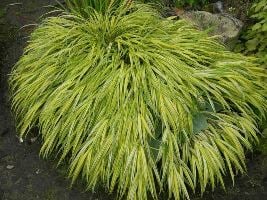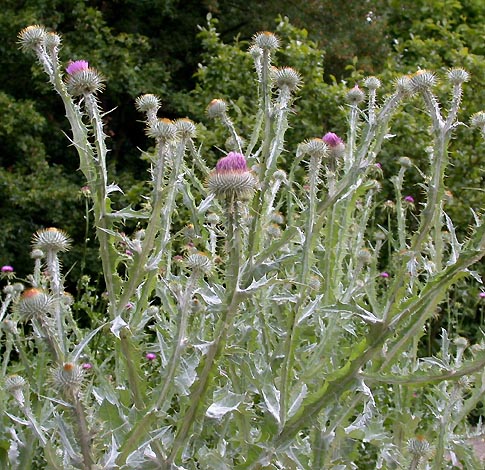Common Ornamental Grasses And Noxious Weeds

Test your identification of common ornamental grasses and noxious weeds of Missouri. Produced by Shaw Nature Reserve and St. Louis County Public Works.
- 1.
- A.
Maiden grass, Miscanthus
- B.
Native sedge, Carex
- C.
Japanese forest grass, Hakonechloa
Correct Answer
C. Japanese forest grass, Hakonechloa -
- 2.
- A.
Indian grass, Sorghastrum
- B.
Big bluestem, Andropogon
- C.
Little bluestem, Schizachyrium
Correct Answer
C. Little bluestem, Schizachyrium -
- 3.
- A.
Japanese forest grass, Hakonechloa
- B.
Sedge, Carex
- C.
Maiden grass, Miscanthus
Correct Answer
B. Sedge, Carex -
- 4.
- A.
Hardy pampas grass, Erianthus or Saccharum
- B.
June grass, Koeleria
- C.
Noxious Johnson grass, Sorghum
Correct Answer
A. Hardy pampas grass, Erianthus or Saccharum -
- 5.
- A.
Switch grass, Panicum
- B.
Moor grass, Sesleria
- C.
Fountain grass, Pennisetum
Correct Answer
A. Switch grass, Panicum -
- 6.
- A.
Frost grass, Spodiopogon
- B.
Melic grass, Melica
- C.
Moor grass, Sesleria
Correct Answer
C. Moor grass, Sesleria -
- 7.
- A.
Native switch grass, Panicum
- B.
Noxious Johnson grass, Sorghum
- C.
Native big bluestem, Andropogon
Correct Answer
C. Native big bluestem, AndropogonExplanation
The correct answer is Native big bluestem, Andropogon. This answer is supported by the information provided in the question, which lists different types of grasses. Among these grasses, only big bluestem is mentioned as being native, and its scientific name is Andropogon. Therefore, it can be concluded that the correct answer is Native big bluestem, Andropogon.Rate this question:
-
- 8.
- A.
Japanese blood grass , Imperata
- B.
Ribbon grass, Phalaris
- C.
Indian grass, Sorghastrum
Correct Answer
A. Japanese blood grass , Imperata -
- 9.
- A.
Blue oat grass, Helictorichon
- B.
River oats, Uniola or Chasmanthium
- C.
Melic grass, Melica
Correct Answer
B. River oats, Uniola or Chasmanthium -
- 10.
- A.
Cut-leaved teasel, Dipsacus laciniatus
- B.
Common teasel, Dipsacus fullonum
- C.
Purple coneflower, Echinacea purpurea
Correct Answer
B. Common teasel, Dipsacus fullonum -
- 11.
- A.
Side oats grama, Bouteloua
- B.
Needle grass, Stipa
- C.
Dropseed, Sporobolus
Correct Answer
B. Needle grass, Stipa -
- 12.
- A.
Feather grass, Stipa
- B.
June grass, Koeleria
- C.
Indian grass, Sorghastrum
Correct Answer
B. June grass, Koeleria -
- 13.
- A.
Blue oat grass, Helictorichon
- B.
Needle grass, Stipa
- C.
Little bluestem, Schizachyrium
Correct Answer
A. Blue oat grass, Helictorichon -
- 14.
- A.
Native Virginia creeper, Parthenocissus quinquefolia
- B.
Noxious kudzu, Pueraria lobata
- C.
Noxious purple loosestrife, Lythrum salicaria
Correct Answer
B. Noxious kudzu, Pueraria lobata -
- 15.
- A.
River oats, Uniola or Chasmanthium
- B.
Quaking grass, Briza
- C.
Blue oat grass, Helictorichon
Correct Answer
B. Quaking grass, Briza -
- 16.
- A.
Giant reed, Arundo
- B.
Reed canarygrass, Phalaris
- C.
Noxious marijuana, Cannabis sativa
Correct Answer
A. Giant reed, Arundo -
- 17.
- A.
Purple coneflower, Echinacea purpurea
- B.
Cut-leaved teasel, Dipsacus laciniatus
- C.
Common teasel, Dipsacus fullonum
Correct Answer
B. Cut-leaved teasel, Dipsacus laciniatus -
- 18.
- A.
Feather reed grass, Calamagrostis
- B.
Dropseed, Sporobolus
- C.
Indian grass, Sorghastrum
Correct Answer
A. Feather reed grass, Calamagrostis -
- 19.
- A.
Cord grass, Spartina
- B.
Ribbon grass, Phalaris
- C.
Noxious Johnson grass, Sorghum
Correct Answer
A. Cord grass, Spartina -
- 20.
- A.
Dropseed, Sporobolus
- B.
Indian grass, Sorghastrum
- C.
Feather reed grass, Calamagrostis
Correct Answer
A. Dropseed, Sporobolus -
- 21.
- A.
Noxious musk thistle, Carduus nutans
- B.
Noxious Canada thistle, Cirsium arvense
- C.
Noxious Scotch thistle, Onopordum acanthium
Correct Answer
B. Noxious Canada thistle, Cirsium arvense -
- 22.
- A.
Moor grass, Sesleria
- B.
June grass, Koeleria
- C.
Buffalo grass, Bouteloua
Correct Answer
C. Buffalo grass, Bouteloua -
- 23.
- A.
Noxious Johnson grass, Sorghum
- B.
Ribbon grass, Phalaris
- C.
Native Indian grass, Sorghastrum
Correct Answer
A. Noxious Johnson grass, Sorghum -
- 24.
- A.
Noxious kudzu, Pueraria lobata
- B.
Noxious marijuana, Cannabis sativa
- C.
Poison ivy, Toxicodendron radicans
Correct Answer
B. Noxious marijuana, Cannabis sativa -
- 25.
- A.
Maiden grass, Miscanthus
- B.
Gray beard, Spodiopogon
- C.
Big bluestem, Andropogon
Correct Answer
A. Maiden grass, Miscanthus -
- 26.
- A.
Noxious Johnson grass, Sorghum
- B.
Ribbon grass, Phalaris
- C.
Native Indian grass, Sorghastrum
Correct Answer
B. Ribbon grass, Phalaris -
- 27.
- A.
Noxious kudzu, Pueraria lobata
- B.
Noxious field bindweed, Convolvulus arvensis
- C.
Noxious marijuana, Cannabis sativa
Correct Answer
B. Noxious field bindweed, Convolvulus arvensis -
- 28.
- A.
Both images are of noxious weeds
- B.
Both images are of native grasses
- C.
The left image is of a noxious weed and the right is of a native grass
- D.
The left image is of a native grass and the right is of a noxious weed
Correct Answer
D. The left image is of a native grass and the right is of a noxious weedExplanation
Native Indian grass, Sorghastrum
Noxious Johnson grass, SorghumRate this question:
-
- 29.
- A.
Pampas grass, Erianthus
- B.
Frost grass, Spodiopogon
- C.
Maiden grass, Miscanthus
Correct Answer
B. Frost grass, Spodiopogon -
- 30.
- A.
Frost grass, Spodiopogon
- B.
Native sedge, Carex
- C.
Melic grass, Melica
Correct Answer
C. Melic grass, MelicaExplanation
The given answer states that the correct answer is "melic grass, Melica". This suggests that out of the three options provided (frost grass, native sedge, and melic grass), the correct answer is melic grass, specifically the species Melica.Rate this question:
-
- 31.
- A.
Noxious Scotch thistle, Onopordum acanthium
- B.
Noxious Canada thistle, Cirsium arvense
- C.
Noxious musk thistle, Carduus nutans
Correct Answer
C. Noxious musk thistle, Carduus nutans -
- 32.
- A.
Noxious Johnson grass, Sorghum
- B.
Ribbon grass, Phalaris
- C.
Native Indian grass, Sorghastrum
Correct Answer
C. Native Indian grass, Sorghastrum -
- 33.
- A.
Noxious purple loosestrife, Lythrum salicaria
- B.
Noxious multiflora rose, Rosa multiflora
- C.
Not a noxious weed
Correct Answer
A. Noxious purple loosestrife, Lythrum salicaria -
- 34.
- A.
Blue oat grass, Helictorichon
- B.
Native dropseed, Sporobolus
- C.
Native wild rye, Elymus
Correct Answer
C. Native wild rye, Elymus -
- 35.
- A.
Blue fescue, Festuca
- B.
Switch grass, Panicum
- C.
Little bluestem, Schizachyrium
Correct Answer
A. Blue fescue, Festuca -
- 36.
- A.
Noxious Canada thistle, Cirsium arvense
- B.
Noxious musk thistle, Carduus nutans
- C.
Noxious Scotch thistle, Onopordum acanthium
Correct Answer
C. Noxious Scotch thistle, Onopordum acanthium -
- 37.
- A.
Switch grass, Panicum
- B.
Fountain grass, Pennisetum
- C.
Native wild rye, Elymus
Correct Answer
B. Fountain grass, Pennisetum -
- 38.
- A.
Multiflora rose is a desirable plant
- B.
Both flowers are native
- C.
The white flower is a native rose and the pink flower is a noxious weed
- D.
The pink flower is a native rose and the white flower is a noxious weed
Correct Answer
D. The pink flower is a native rose and the white flower is a noxious weed -
- 39.
- A.
Noxious Scotch thistle, Onopordum acanthium
- B.
Noxious common teasel, Dipsacus fullonum
- C.
Noxious spotted knapweed, Centaurea stoebe ssp.micranthos
Correct Answer
C. Noxious spotted knapweed, Centaurea stoebe ssp.micranthos -
- 40.
- A.
Noxious marijuana, Cannabis sativa
- B.
Virginia creeper, Parthenocissus quinquefolia
- C.
Poison ivy, Toxicodendron radicans
Correct Answer
C. Poison ivy, Toxicodendron radicans -
Quiz Review Timeline +
Our quizzes are rigorously reviewed, monitored and continuously updated by our expert board to maintain accuracy, relevance, and timeliness.
-
Current Version
-
Mar 21, 2023Quiz Edited by
ProProfs Editorial Team -
Oct 19, 2009Quiz Created by
Snr
 Back to top
Back to top









































